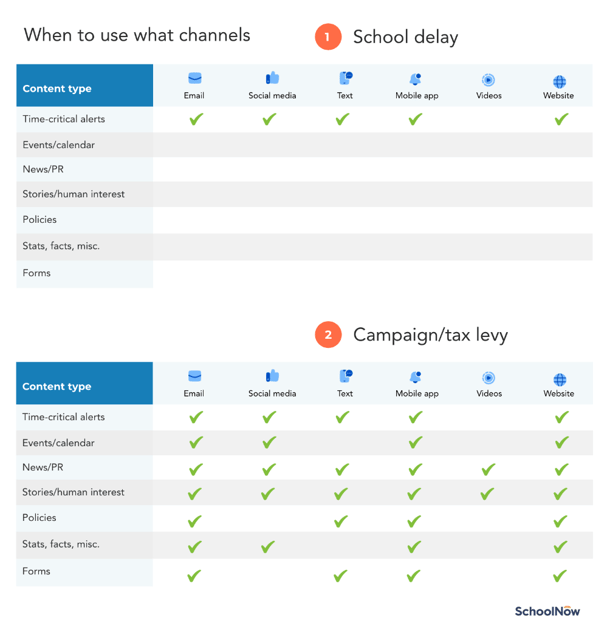It’s easy to recognize that great communication is at the heart of any great school. What’s not so easy to grasp these days is identifying which communication channels to focus on, and when to use them to reach your audiences.
Although there is more technology than ever for connecting with parents, staff, students and the rest of your school community, there are questions and costs that come with learning how to make the most of using it.
Improving your school communications while being realistic about your resources might be the greatest challenge facing you and just about every other school communicator. By the time you factor in the tools, training, time, staffing, and tech support, staying current with all these channels can be challenging if not cost-prohibitive.
Nevertheless, in your school communications planning you need to focus on using and embracing technology and using all the channels at your disposal. I’ve identified the six key areas that you need to focus on to be a great school communicator and improve engagement for your school or district.
Granted, these channels are subject to technological advancements. And while it is impossible to predict what next big thing is around the corner, I can tell you these channels are critical for your school for now – your website, social media, notifications, mobile app, emails, and video.
Types of school communications
How and when to share school information has changed dramatically in recent years. What hasn’t changed, really, are the kinds of information that need to be shared. Most of your school information you want to share falls into the following categories:
- Promotion of school happenings and news (e.g., achievements, events, etc.)
- Time-critical school information (e.g., school closings, policies, etc.)
- PTO events and other important issues
- Leadership and education improvement ideas (e.g., parent resources)
- School levy and community outreach (including fundraising)
- Stories and imagery of the school's impact on the community (cool human interest content, alumni, photos, videos)
Now we can ask, “How do I use today’s channels for sharing this information?” While schools are not in the business of technology and communication, you still have to do your best and rely on providers that specialize in these channels. Hopefully, you can find partners who provide simple ways to communicate without having to hire multiple vendors to achieve success.
Key school communication channels
I’ve listed below a matrix that shows how to use each channel and discuss a little more in detail each of the areas.
There are plenty of options, and each channel is used differently and in some cases, at the same time. The goal here is to communicate continuously and while recognizing the purpose and limitations of each channel. When used properly, your parents, staff and students will appreciate it.
Not all channels are meant for every kind of communication from your school. While a text message to a parent is helpful when there’s a one-hour weather delay, text messages about, say, the score of the Friday night football game, is hardly news that needs to be pushed via emergency notification.
The importance of understanding these channels and how to use them are critical for effective communication. I’ve list below each channel and the key purpose of each to help you better utilize them.
- District and school website
- Text and voice
- Mobile app
- Video
- Social Media
- Website

1. Email
The email channel is an oldie but goodie and a key channel for schools. We all love it because it is a great form of one-to-one personal communication. Most parents have email accounts, and it allows the school to provide information of all kinds, in detail if needed. Email also features a very high open rate, which translates into an informed community.
The use of email can range from reminders, policies, registration, newsletters, and a variety of announcements. A majority of the content sent in email needs to exist on the website and be easily linked to. Email can be the messenger for your website content – still the hub of much of your school information.
Email needs to be a channel that is mastered by schools and utilized to its fullest. There are several best practices that can improve open rate and overall readability. Most email blasting systems, which provide a higher degree of email security than one a school handles itself, enables important metrics that can help you improve your communication.
2. Text and voice
Critical emergency information and important reminders need to be communicated through a notification system that provides SMS (text), voice, and email. There are many notification providers to choose from. These types of systems may or may not integrate with other channels but serve a purpose for time-critical messages. Parents typically have the ability to customize their preferences and receive the preferred method of communication.
Schools need to be sensitive to how this type of messaging is utilized. Like alerts via mobile apps, you do not want to overuse notifications. It is an extremely effective means of communication but can become annoying if you are getting voice messages about not-so-important information.
A few notification facts:
- Over 70% of K-12 parents age-group (25-54) have smartphones
- Texting preferred over voice calls
- For every 1 text message sent, 10 emails are sent
- For every 1 text message sent, 12 voice calls are made
3. Mobile app
Mobile apps are becoming a very popular method for schools to communicate. A mobile app can make it efficient to access common information like alerts, calendars, directories, news and lunch menus. Plus it can make it simple to integrate the phone, email and texting features into the app, making it even more useful. While the mobile app is not ready to replace the website, the website pages need to be accessible through the app.
The main benefit of the mobile app is going to be the push notifications. Do not overuse push notifications. Rather, save them for important, time-sensitive announcements and alerts.
There are other key features a school mobile app should have, but one of the most important is the ability to segment your notifications to the specific audience respectively. For example, if the middle school football game is canceled, you should not notify the elementary and high school parents.
4. Video
Videos and the favored channels to share them – Youtube, Vimeo, Vine, and Periscope – are becoming popular because we all love the medium. Like all the channels I’ve covered, however, there’s a time and place for video.
Whether it’s live streaming events or recording for posting at a later time, video is a crowd-pleasing way for schools to capture, chronicle, and archive great school content.
When it comes to a how-to video, a personal message, highlights from an event, something humorous, touching or otherwise entertaining, video rules. Video is not, however, the best way to depict something time critical.
Some schools are even creating their own Youtube channels. using them to post everything from football highlights, to school productions, to the superintendent’s messages. Even if you don’t have a Youtube channel, you can create video galleries and archives of your school events.
5. Social Media
These popular social media channels are driving how many businesses and organizations are sharing information. They need to be a big part of your communications mix as well. Understanding which social media to use and when to use it requires understanding the limits and life cycle of the content posted to each of these channels.
Facebook, Twitter, Instagram, and Youtube are the key channels we’re talking about here. There are others, but these are what your school should be using to reach the increasingly digital and mobile stakeholders your school serves. The beauty of social media is how easily the content can be linked to other social media channels, and how easily it can be shared with many people.
Regardless of which media you’re utilizing, building a following and, in turn, encouraging sharing (see viral) is what it’s all about. For a solid drill down on making the most of social media at your school, check out this article and a link to the Social Media Guide for Schools.
Whether you’re Tweeting out 140-character messages several times a day, making daily Facebook pages, or weekly blog posts, all these vehicles and others can be utilized at the right time to get your messages across.
6. Websites
A website serves an important purpose for school districts and its schools: to be a self-service portal for all information for the school. Websites have changed over the years in how they are designed. A good one is accessible on mobile devices and serves as a hub for social media and other channels. This entails creating a website with responsive design featuring tools that make it easy to manage and share content.
The key to having a successful website that supports all other communication is that it is easy to use and shows all updates of communication that is being shared. For example, if you are promoting a big event, you should have it featured as a news announcement, homepage banner and even a calendar event. Depending on the degree of your CMS integration, it may automatically update, or you may have to update the website manually.
Many schools also use their websites to conduct e-commerce for a variety of payments. In addition, submission forms are used on school websites to gather information or conduct registration for events or enrollment.
A word about non-digital communications
It’s important when plugging your school content into the right channels that you not forget the non-digital parents. It may be hard to believe, but there are actually parents who have no email accounts nor smartphones, so it’s important that you not overlook the old-school ways of getting messages to them.
Printed newsletters, the time-tested take-home packet that’s jammed into kids’ backpacks, solid media relations to get that school closing to the TV stations, school signage, posters, and flyers. These are all areas that will not only help you continue to reach your tech-less parents but can supplement your communications through digital channels.
Printed and other non-digital communications should be used to cross-promote your digital channels too. Place social media badges and icons on select printed media (like us on Facebook, follow us on Twitter, tune in our YouTube channel, etc.) to show all your audiences that you’re doing all you can to reach them.
School content at the right place, time, and price
Over the years, I’ve answered questions from thousands of school administrators looking for new website designs or website hosting solutions. But of late, the questions are now including how to integrate website communications with all these other channels I’ve mentioned here.
Keeping up with communication trends these days does require a scorecard of sorts and a way of figuring out how to use all these channels without breaking your school communications budget.
Whenever you have school content that needs to be shared, examine all your communications channels, and be sure you have the information queued up in the right channel at the right time. And be on the lookout for tools to help you manage the task of playing traffic cop for the growing amount of content traveling the avenues available in this digital age.
Topics: Communication
About the author
Marketing director and content strategist for SchoolNow, Jay’s a former school public relations specialist who’s helped businesses, schools and colleges use the power of communications to improve their image, generate support, and optimize relationships. Reach him at jay@schoolnow.com.
.png?width=64&height=63&name=Group%20(4).png)
.png?width=66&height=64&name=Group%20(5).png)
.png?width=56&height=60&name=Group%20(6).png)
.png?width=66&height=52&name=Group%20(7).png)
.png?width=56&height=56&name=Group%20(9).png)
.png?width=59&height=52&name=Group%20(10).png)

